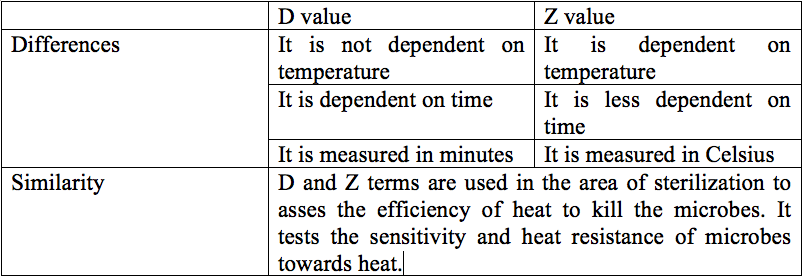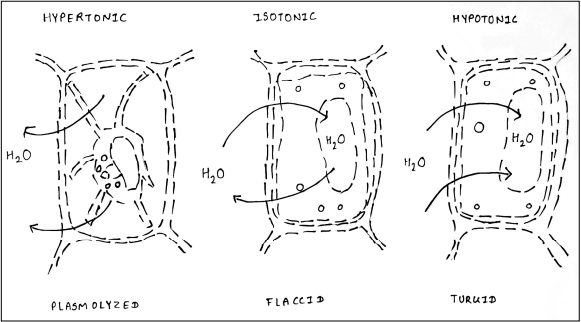D and Z values are important terms to determine the efficiency of sterilization by using heat. Heat is one of the best physical methods for killing microbes because of its penetrating power. Heat causes dehydration and denaturation of cellular biomolecules. The tolerance of heat varies from microbe to microbe. The extent and rate of bacterial destruction is directly related to temperature and time.
Table of Contents
- Introduction
- Principle
- Procedure to find the D value
- Procedure to find the Z value
- Result
- Conclusion
- Activity
Introduction
The D and Z terms are a part of the mathematical calculation used to determine the sensitivity of microbes to temperature, possible number of microbes that can be killed, and to find out the safe and acceptable number of bacterial survivors left after exposing it to heat. These mathematical terms are mostly used and followed in Food and Dairy Industry to keep their products free from pathogen and safe for consumption.
When the bacterial suspension is exposed to heat, it shows logarithmic decrease in its population. It means that when microbes are exposed to heat at a particular temperature for specific time, same percentage of microbes would die every time. This characteristic is used for thermal mathematical calculation. Hence, D and Z values are used to determine the heat sensitivity and resistance of microbes.
Thermal Death Time
Thermal Death Time (TDT) is also one of the frequently used terms, and is defined as the time required for killing specific number of microorganisms at a particular temperature. Practically, to obtain thermal death time value, the temperature is kept constant and the required time is found out to kill the specific or target number of microbial cells. In short, temperature is constant and the required time is found.
The mathematical thermal calculation terms like TDT, D value and Z value are used to estimate the efficiency of sterilization. The D value indicates the time required for killing a given microbe at particular time and at a particular temperature. The D value can be used to check the efficiency of sterilizing agent like heat, chemical, or radiation. The D value is defined as the time (in minutes) required for killing 90 percent (one log cycle) of any specific microorganism at given temperature. The D value varies from microbe to microbe because their sensitivity to sterilizer varies. The log term is a mathematical representation of the linear reduction of elimination of microbes at the given temperature. One log cycle means the number of microbes has been reduced by 10 times or we can say that it has been reduced to 90% of the total pollution, and hence it is called as Decimal Reduction Value (D value). The lower the D value is, the higher is the efficiency of any sterilizing agent.
The D value of any microbe is affected by the type of microorganism, temperature, and media composition. When Microbial suspension is heated at a specific temperature, the populations of microbe start decreasing, and follow the logarithmic order of death.
When microorganisms are exposed to heat, there is a decrease in the microbial number, and it can be observed in the graph, where number of microorganisms per unit volume are plotted against time.
Z value determines the temperature required to kill the microbes. It is defined as the temperature required for altering D value by the factor of 10 or 1 log cycle. It is used to determine the bacterial mortality rate at a particular temperature. These terms are important and applied in Food and Dairy Industry, because it is crucial to kill the microbes, but at the same time it is also vital to maintain nutritional quality of food. Because the temperature also affects the structure and native conformation of nutritionally important biomolecules like proteins, enzymes, and vitamins etc.
Principle of D & Z Values
The D value is the time required to kill 90% of microbial population at definite time and definite media. To determine the D value, survival plot is obtained by plotting log of microbes against time at a particular temperature. From the survival plot, it is observed that at a particular temperature the numbers of microbes are decreased by a factor of ten.

Z value is the change in temperature made to decrease D value by 1 log cycle. To determine Z value, at least two D values of different temperatures must be known. Using the formula mentioned below, the Z value can be determined:
Z = (T2-T1)/(logD1-logD2)
Procedure to find the D value:
- The desired microbial culture of which D value is to be calculated is inoculated in the media, and incubated for 24 hours in the incubator.
- The initial microbial population is measured using spectrophotometer.
- The incubated culture is exposed to heat at 65 °C.
- The final microbial population is measured using spectrophotometer.
- The initial and final microbial population value is put in D value formula.
In order to convert the absorbance into concentration, click here.
Procedure to find the Z value:
The above procedure is repeated at 75 °C and D value for this temperature is found out. Putting the D values for both the temperatures in Z formula, the Z value is determined.
Result:
The D value is found to be……………
And Z value is found to be………….
Conclusion:
The D and Z value are useful mathematical terms used to study the sensitivity, resistance, and lethality of microbes to heat.
Difference and similarity between D and Z value:

Activity:
- One log cycle means reduction of microbes is 10 times
- Two log cycle means reduction of microbes is 100 times
- Three log cycle means reduction of microbes is_______ times
- Four log cycle means reduction of microbes is _______ times
- Five log cycle means reduction of microbes is _______ times
- Six log cycle means reduction of microbes is _______ times
- Seven log cycle means reduction of microbes is _______times
- Eight log cycle means reduction of microbes is _______ times
- Nine log cycle means reduction of microbes is _______ times
- Ten log cycle means reduction of microbes is _______ times
Need more help? Click here.


